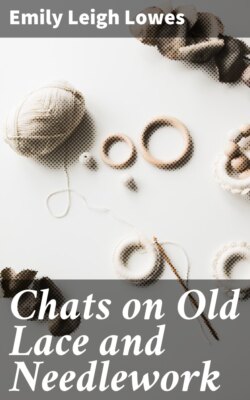Читать книгу Chats on Old Lace and Needlework - Emily Leigh Lowes - Страница 6
На сайте Литреса книга снята с продажи.
II
THE ART OF LACE-MAKING
ОглавлениеTable of Contents
Needlepoint—Pillow Laces—Charts of various Réseaux—Technical Terms.
Lace-making naturally falls into two classes—the Needlepoint and Pillow varieties. In some laces, more especially of the Belgian class, there is a mixed lace, the "toile" or pattern, being worked with the needle, and the ground, or "réseau," made round it on the pillow and vice versâ.
To the first-named class we must assign the Needlepoint laces of Italy and the exquisite handmade laces of France. To the latter order belong the early Macramé lace, called "Punto a Groppo"; the Genoese and Milanese laces of Italy; Mechlin and Brussels of Belgium; Valenciennes, Lille, and Chantilly of France; and the English laces of Honiton, Buckinghamshire, and Bedfordshire.
Pillow lace may be easily distinguished from Point lace, as in the former the ground, or réseau, is made of plaited threads. That of Point lace is composed of threads made by the use of the buttonhole stitch only, or, in the case of Alençon point, the mesh is worked in a special manner. The later laces, i.e., those made during the last hundred years, have frequently a ground of machine lace, and thus, strictly speaking, are not lace at all, but only embroideries or appliqués. The machine-made ground can be distinguished by sense of touch alone. If we take a piece of hand-made net between the finger and thumb and slightly roll it, it will gather in a soft little roll, with the touch almost of floss silk. The machine-made net is hard, stiff, and wiry, and remains perceptibly so in this test. Also, the mesh of machine-made lace is as regular as though made with a fine machine fret-saw, that of hand-made lace being of varying sizes, and often following the pattern of the lace design.
The accompanying diagram illustrates the various grounds, and will prove an infallible guide in distinguishing the points of difference between Point and Pillow lace.
Various special and technical terms are used in describing the method of making lace. Without burdening the reader too much, a few special terms must be explained.
Brides (literally "bridges").—These are the connections between the various parts of a lace design, both in Needle-point and Bobbin lace. In the former, they are made entirely of a strand or two of thread thrown across, and then buttonholed over, sometimes with tiny loops on the edges, and in Venetian lace often having minute stars worked upon them.
PILLOW RÉSEAUX. No. 1.—Valenciennes. No. 2.—Brussels. No. 3.—Lille. No. 4.—Mechlin.
Beading.—A tiny looped edge used to finish woven or Pillow-made lace.
Bobbins.—One of the essential parts of a Pillow worker's outfit. These are small, elongated bobbins made of ivory, bone, or wood, on which is wound the lace-maker's thread. Sometimes they have been made very ornamental with carving and other decorations, and frequently have "gingles," or a bunch of coloured beads attached to one end. The terms "Bobbin lace" and "Bone lace" are derived from these and are synonymous with "Pillow lace."
Cordonnet.—In most Point laces the design is outlined with a raised cord either worked over closely with buttonhole stitches, or made separately and then stitched down. The Cordonnet is one of the characteristic features of the raised Venetian points and the French laces of Alençon or Argentan.
Couronnes.—These are decorations of the Cordonnet especially noticeable in the raised Venetian laces, in which sometimes the lace is raised and worked upon no less than four separate times.
Dentelé.—Lace designed in scallop-form, chiefly used for border laces.
Fillings.—This word most easily explains the ordinary terms of "modes" and "à jours." The inner parts of the pattern in Needlepoint and Pillow lace are filled in with various ornamental stitches, showing an amazing variety of design. By these fillings various laces may often be distinguished, as each factory had its favourite "modes."
Grounds.—There are two varieties of grounds, one made with Brides, and the other either with Needlepoint or Pillow network. Other names for these are "Réseaux" and "Fonds." The method of making Needlepoint or woven ground often decides the date and class of the lace.
Guipure.—Literally a tape lace. The name however is applied to all Pillow laces having a tape-like design on them.
Picots.—The little loops used to ornament a plain bride or tie.
VENETIAN ROSE POINT. (S.K.M Collection.)
